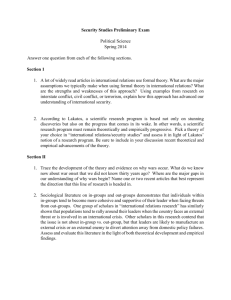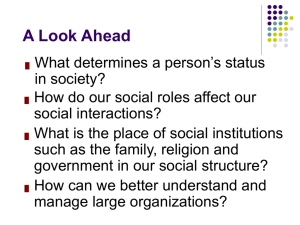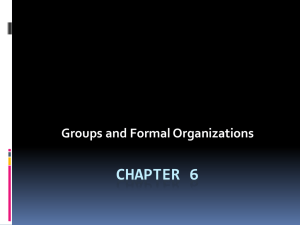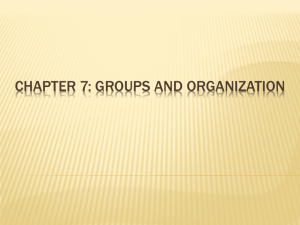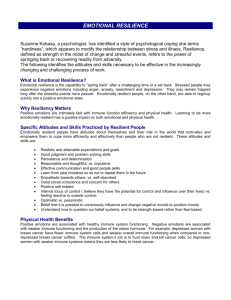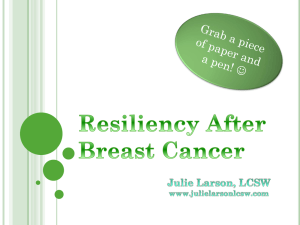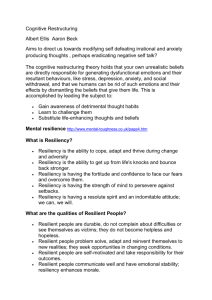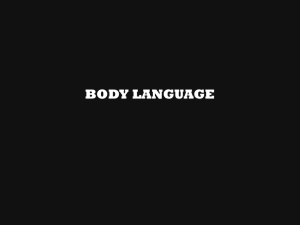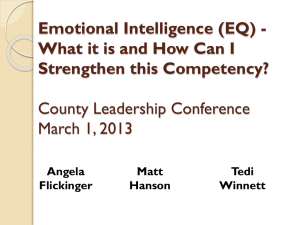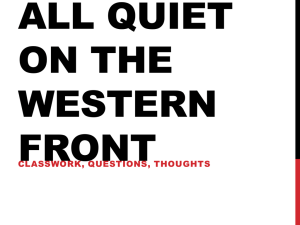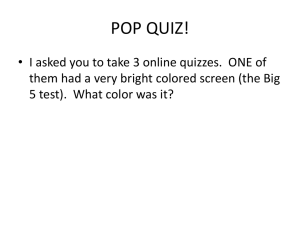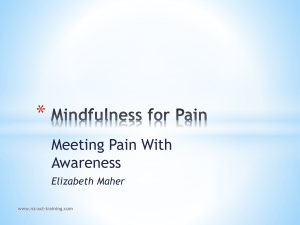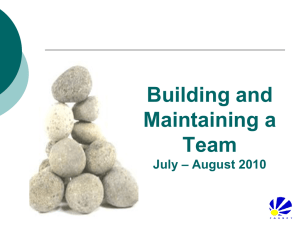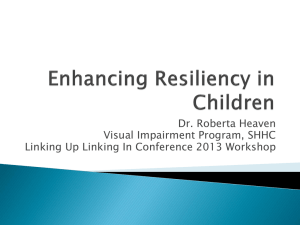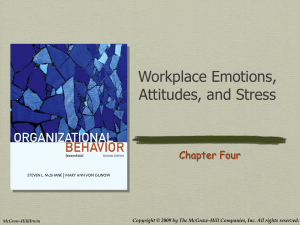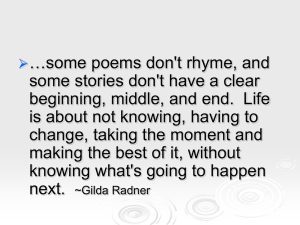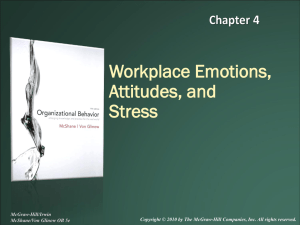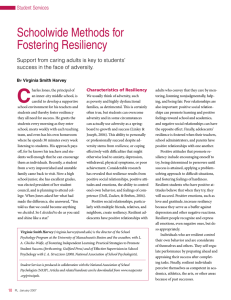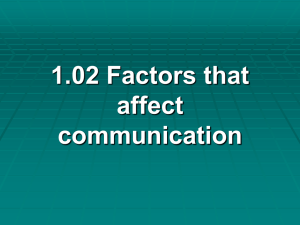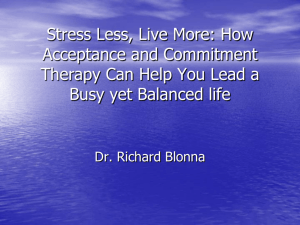File - David Rude, Instructor
advertisement
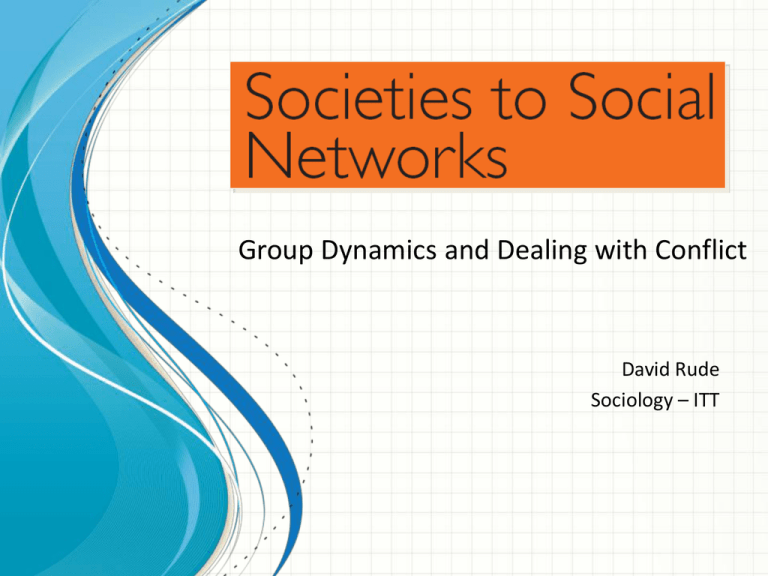
Group Dynamics and Dealing with Conflict David Rude Sociology – ITT What is Conflict? • Simply put: conflict is (often/usually) the result of miscommunication. • What does miscommunication look like? Attitudes towards Conflict I am going to read several statements about conflict. If you agree with what I read, stand up. • Conflict is something you know. Every relationship experiences conflict at one time or another because each person is different. When you hear the word “conflict,” what words comes to mind? How do you define “conflict”? Conflict can cause a lot of stress in people’s lives. It can hurt and damage relationships with others. However, conflict can also be positive. Can you identify when conflict is positive? A Conflict Workshop One, more in depth, definition is that conflict is a dynamic process reflecting the interaction of two or more interdependent parties who have some level of difference or incompatibility between them. This definition suggests that there are four important aspects of conflict. 1. There is some level of interdependence between the people. In other words, people are dependent upon one another to meet their needs, goals, or interests. 2. There is a significant relationship between the people, such as family, friend, co-worker, or teammate. 3. There is some kind of threat or struggle between them that is either real or perceived. 4. Negative emotions, such as anger, frustration, or fear, are ignited. Levels of Conflict Intensity There are different levels of conflict intensity. By understanding the possible escalation of conflict, it is possible to keep a conflict from moving to a higher level through interpersonal communication skills Level One – Differences: People have different views about things, such as the views that were discussed in the Icebreaker activity. Level Two – Misunderstandings: People often misunderstand each other. People make assumptions, and “filter” what others say through their own experiences, knowledge, and beliefs. Level Three – Disagreements: “Disagreements are basically differences with an attitude.” It is okay to disagree with someone. People can explore their disagreements, and they can even debate issues to learn from each other. The danger lies in letting emotions get out of control. Level Four – Discord: Conflict at this level “is characterized by generally deteriorating relationship between the conflict partners.” The discomfort is apparent not only in discussing the issue, but also in dealing with the person. Emotions tend to run high at this point. Level Five – Polarization: This is the nasty stage of conflict that is damaging to relationships. People often recruit others to join their cause; make themselves “right” and others “wrong”; expend a lot of energy to defend their position and demean the other person; and refuse to work toward resolving the conflict. The good news is that people can make conscious choices about their responses to conflict and take responsibility for their behavior. While a person cannot control the behavior of others, a person can control his or her own actions—or at least try, which is, admittedly, very hard to do. CONFLICT inventory Conflict Resiliency Inventory SCORING KEY 15-39 Hmmm…I guess you already know you are not conflict resilient and working on conflict resiliency is highly recommended. 40-54 Your conflict resilience quotient is low and conflict resiliency work is recommended 55-69 You are conflict resilient with a few areas that could use some work to strengthen your skills even more. 70-75 You are definitely conflict resilient! D.E.R. Scripts Describe a problem clearly and objectively. Produce the least amount of resistance Three Parts – D = Describe the problem. – E = Express your thoughts or feelings. – R = Request what you want D.E.R. Scripts Common errors in D (Describe) Over generalize Words like “never,” “always,” and “every.” Be specific to time and place Too long • 3 Sentences maximum D.E.R. Scripts • Common errors in E (Express) – Too emotional • Low key is best • Disappointed, upset, angry, concerned – Blaming – Trying to make the other person feel bad – Mind-reading or psychoanalyzing • Guessing at goals, attitudes, or intentions. D.E.R. Scripts • Common errors in R (Request) – Not stating what you want – Using unclear or vague terms • Examples: respect, responsible • State in behavior terms – what you want the person to do – Asking for changes in personality or deeply entrenched behaviors Interpreting Self Control Conflicts - video Worksheet – How I Deal with Conflict Take about ten minutes to complete the questionnaire. We will then discuss as a group. • Video : How a family dealt with conflict Final Discussion You will have many differences with people throughout your lifetime; differences are part of our humanity. How you respond to these differences and deal with conflict is a choice you can make. Let’s focus on specific things you can do. • How do you know when your emotions are rising? • What signals does your body give you? A technique for dealing with emotions in difficult situations is “Go to the Balcony,” a concept coined by William Ury (1991). It means taking a detached and distanced view of the person or situation—as if you were in the balcony watching a performance on stage. It does not mean being cold, unfeeling, or nonunderstanding. Instead, it means not taking the other person’s actions personally, even if the person is being personal. The intent is to try to disconnect the automatic link between emotions and actions Conflict is a part of your life, and you will find it at home, school, and work. It can cause great stress and often damages important relationships. Conflict can also bring about needed changes and opportunities. It can take relationships to more meaningful levels. Leaders who have mastered effective conflict skills are not only respected, they are the ones that others want to follow. Reflection and Application activity sheet Reflect, specifically, on why it is important for leaders to deal with conflict effectively. What is a group? “People who interact with one another and think of themselves as belonging together.” Why groups or teams sometimes don’t work well together. 1. Absence of trust—unwilling to be vulnerable within the group 2. Fear of conflict—seeking artificial harmony over constructive passionate debate 3. Lack of commitment—feigning buy-in for group decisions creates ambiguity throughout the organization 4. Avoidance of accountability— ducking the responsibility to call peers on counterproductive behavior which sets low standards 5. Inattention to results—focusing on personal success, status and ego before team success Groups within groups Primary Groups • Face-to-Face • The Family • Friends Secondary Groups • • • Larger, More Anonymous Members Interact Based on Statuses Fail to Satisfy Need for Intimate Association In-Groups and Out-Groups • Loyalty to In-Groups • Antagonism Towards Out Groups – Gay Teens - video Reference Groups • Evaluating Ourselves • Expose Us to Contradictory Standards Groups Within Society 1 • Social Networks and Cliques 2 • The Small World Phenomenon - Milgram 3 • Six degrees of separation Electronic Communities – People Connect Online – Newsgroups – Online Chat Rooms • Some Meet Definition of Group ACTIVITY Compare & contrast groups GROUP DYNAMICS GROUP SIZE AFFECTS STABILITY AND -INTIMACY -DYAD -TRIAD -COALITIONS AS SIZE INCREASES, SO DOES STABILITY AS SIZE INCREASES, INTENSITY AND INTIMACY DECREASE Group Dynamics • Effects of Group Size on Attitudes and Behavior • The Larger the Group… – Greater Diffusion of Responsibility – Increase in Formality – Division into Smaller Groups Leadership Who Becomes a Leader? Types of Leaders • Instrumental - motivated by results • Expressive - motivated by relationships. Leadership Styles –Authoritarian –Democratic –Laissez-Faire • Leadership Styles in Changing Situations • Leadership workshop -------- Homework: Unit 5 Assignment 1: Societal Influence Answer the three “Thinking Critically about Chapter 5” questions on page 151 of the textbook: • How would your orientations to life (your ideas, attitudes, values, goals) be different if you had been reared in a hunting and gathering society? In an agricultural society? • Identify your in-groups and your out-groups. How have your in-groups influenced the way you see the world? What influence have your out-groups had on you? • Asch’s experiments illustrate the power of peer pressure. How has peer pressure operated in your life? Think about something that you did not want to do but did it anyway because of peer pressure. QUESTIONS?
